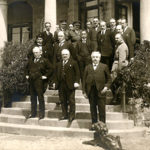Published June 6, 2014
Where the Gold Standard Act of 1984 Came From–and Why It’s Still Relevant
By John D. Mueller[1]
Kemp Forum on Growth, 30th Anniversary of the Gold Standard Act of 1984
U.S. Capitol, Washington, DC, 6 June 2014
I’d like briefly to outline the debate that occurred among advisers to Jack Kemp (1935-2009) in the early 1980s and led to Jack’s introduction of the Gold Standard Act of 1984–then explain why the agreement on gold that eluded Ronald Reagan’s advisers is now possible.
The essence of the “supply-side” approach to economic policy was that monetary and fiscal policy are inherently separable. The previous consensus going back to John Maynard Keynes was that monetary and fiscal policy always work in the same direction.
The idea that you can have a different “policy mix” is generally credited to Columbia University Professor Robert A. Mundell. As explained by Wall Street Journal editor Robert Bartley: “To combat stagnation plus inflation, you needed two levers: tight money to curb inflation, and tax cuts to promote growth. … In a Keynesian world, of course, tight money would merely offset tax cuts; one would contract aggregate demand while the other expands it. The key was that supply-side tax cuts provided stimulus not by expanding aggregate demand – ‘putting money into people’s pockets’ – but by stimulating supply, by increasing incentives to work and invest.” (Wanniski 1998 [1978]), Introduction to the Third Edition, pp. 366-367)
However, supply-siders who agreed on the tax-cutting half often disagreed about the monetary half of the policy mix. There were three camps. Some were “domestic monetarists” who agreed with Milton Friedman that “tight money” meant controlling the domestic money supply while allowing exchange rates to float. Two other groups argued that this would not work, partly because under floating exchange rates the demand for domestic money is not stable. Instead, monetary policy ought to be governed by some kind of “price rule” – some mechanism by which the central bank supplies all money demanded at a fixed price.
But those who advocated a “price rule” disagreed about which price rule. And in this debate, there were many throwbacks to a debate carried on during the late 1950s and 1960s, as the Bretton Woods system was crumbling into dissolution.
Two economists – Jacques Rueff (1896-1978) and Robert Triffin (1911-1993) – had the distinction of correctly predicting, beginning around 1960, that the Bretton Woods system (then in its heyday) could not last. Under the Bretton Woods system, the United States alone maintained convertibility of the dollar into gold, while other nations kept their currencies convertible into dollar securities. Basing the international monetary system largely on the IOUs of one nation (the United States), Triffin and Rueff proved, was financing a gradual inflation despite a fixed gold price. The monetary IOUs of the United States to foreign central banks kept expanding, but the supply of new gold did not keep up; because rising prices meant rising gold-mining costs, while the output price for gold was constant.[i]
To solve this “Triffin dilemma,” Triffin and Rueff agreed, the international monetary system must be based, not on any single nation’s currency, like the dollar, but on a truly international money. But they disagreed about which.
Triffin argued in favor of a plan originally proposed in 1943 by John Maynard Keynes, which would have set up the International Monetary Fund as the world’s central bank. The IMF would issue its own world-wide paper currency, which all nations’ central banks, including the Federal Reserve, would be required to use to settle international accounts. All the central banks, in effect, would stand in the same subordinate relation to the new world central bank as a domestic commercial bank stands to its central bank. The original Keynes plan was rejected because of its inflationary potential, though Triffin suggested safeguards to reduce this danger.
Rueff, on the other hand, argued for a return to the international gold standard; the central banks of all nations would settle their accounts in gold, not the currency of any nation or of a world central bank. This, Rueff argued, was a viable system with a proven record of price stability. And such a reform, he pointed out, would remove the defect that had caused both the breakdown of Bretton Woods and had permitted the deflationary collapse of the similar monetary system based on the pound sterling in the 1920s and early 1930s. (And, I should add, triggered the Great Recession of 2007-09.)
In the event, Bretton Woods was allowed to collapse, unleashing unprecedented world-wide inflation. Yet, against the expectations of many, the system that emerged, though one of flexible exchange rates, was still based primarily on the dollar.
Friedman’s, Triffin’s and Rueff’s positions were represented among advisers to Jack Kemp. Mundell had long agreed with Triffin’s and Rueff’s analysis of Bretton Woods. He, Jude Wanniski (1936-2005) and other “global monetarists” favored a variation of the Keynes plan, under which the IMF would issue a “gold SDR” (Special Drawing Right; Keynes had called his monetary unit “bancor” – “bank gold” – an oxymoron). However, recognizing that such a plan would be a political non-starter, they fell back on a revival of Bretton Woods. This may seem surprising, since Wanniski’s seminal 1975 article in The Public Interest, “The Mundell-Laffer Hypothesis,” was devoted mostly to explaining why Bretton Woods broke down and to advocating the “gold SDR.” (In that article, tax cuts are mentioned briefly, and the Laffer Curve is literally a footnote: Wanniski 1975) But in Mundell and Wanniski’s view, the international gold standard would be a step backward in what they perceived as an inexorable monetary evolution, while revived Bretton Woods would leave the door open for a future world central bank.[ii] Lehrman and I, joined later by Jeff Bell, favored Rueff’s solution, for the same reasons I have described.
In 1980, Kemp had asked me to draft a bill intended to restore Bretton Woods. I responded with a long memo based on Rueff’s analysis (as well as I understood it), explaining why that would not be a good idea.[iii] Many supply-siders among whom the memo was circulated were students of Laffer and Mundell, and disagreed. But after much internal debate, on June 29, 1984, Jack introduced the Gold Standard Act of 1984 (HR5986), a concise bill which was an honest-to-God gold standard, not a gold-price “rule” or gold “target” under a fiat standard (as Larry White aptly described the policy: Cato Institute 2014).
When he ran for president Jack explained the issue in Rueffian terms. For example, in his May 29, 1987, farm speech he said (Kemp 1988, p. 24):
“Why do we keep having these cycles? I believe it has to do with the burdens and privileges of the dollar’s unique international role. First, the extra demand for dollars puts a premium on their value that makes American exports less competitive. And on world markets, only a few cents mean the difference between a sale and a loss.
“Second, the dollar’s role helps fuel Congress’s deficit spending. Foreign central banks buy U.S. Treasury securities to hold as reserves and to keep their currencies from rising–almost $100 billion in the last year and a half. This amounts to a special ‘line of credit’ that lets Congress spend resources which could otherwise be used to farm or manufacture for export. President Reagan used to say that to get Congress to spend less you have to reduce its allowance. Well, we may have reduced its allowance, but we haven’t taken away its charge card. That’s one reason why every tax dollar is spent without cutting the deficit.
“Trying to compete in world markets under these conditions is like trying to run a race with a ball and chain around your ankle. We face a constant choice between giving in to the pressure to let the dollar fall at the risk of inflation, or keeping interest rates high at the expense of a trade deficit and growing pressure for protectionism. The dilemma will continue until we stabilize the dollar, end the inflation/deflation cycle, and bring down interest rates with the right kind of monetary reform.”
Reagan’s Unfinished Monetary Reform..[iv] Why do I say that it possible now to achieve what Reagan could not because of the disagreements I have described? Though they often disagreed, Milton Friedman and Robert Mundell exhibited colossal integrity in acknowledging that changing circumstances had made their earlier proposals infeasible. As Friedman summarized in a 2003 Financial Times interview, “The use of quantity of money as a target has not been a success. I’m not sure that I would as of today push it as hard as I once did” (London 2003). Similarly, according to a Wall Street Journal interview with Judy Shelton, Mundell believes that “it would not be possible today to forge a monetary system with the dollar as the key reserve currency, as President Franklin Roosevelt and Treasury Secretary Henry Morganthau did in the 1940s. ‘To be fair, America’s position is not nearly as strong now,’ he concedes.’” (Shelton 2010).
Thus, it is now finally possible to restore the first principle of successful presidential economic policy, which goes back to George Washington and his Treasury Secretary Alexander Hamilton. As Rueff showed, the essential requirement is that the major countries agree to replace all official foreign-exchange reserves with an independent monetary asset that is not ultimately some particular nation’s liability: gold.[v]
John Mueller is the Lehrman Institute Fellow in Economics at the Ethics and Public Policy Center.
References
Cato Institute (2014). Gold: The Monetary Polaris. Conference on Lewis (2013). (12 February). http://www.cato.org/multimedia/events/gold-monetary-polaris
Friedman, M. (1962) Capitalism and Freedom. University of Chicago Press. Chicago.
Friedman, M. and Schwartz, A.J. (1963) A Monetary History of the United States, 1867–1960. Princeton University Press. Princeton.
Kemp, J.F. (1988) Advancing the American Idea into the ’90s. Campaign for a New Majority. Washington, DC.
_________ (1984a) The American Idea: Ending the Limits to Growth. American Studies Center. Washington, DC
_________ (1984b) “Lower Interest Rates and Economic Growth by Restoring a Golden Rule,” 130 Congressional Record 20314-20317 (29 June)
_________ (1979) An American Renaissance: A Strategy for the 1980s. Harper & Row. New York, NY.
Laffer, A.B. (1982) “Reinstatement of the Dollar: The Blueprint,” Economic Notes 0 (2), 158–176
_________ (1972) “Monetary Policy and the Balance of Payments,” Journal of Money, Credit, and Banking Part I 4 (1), 13–22
_________(1969) “The U.S. Balance of Payments – A Financial Center View,” Law and Contemporary Problems 34 (1), pp. 33–46.
Lehrman, L. E. (2014) The Federal Reserve and the Dollar. Cato Journal, Vol. 34, No. 2 (Spring/Summer). Washington, DC. Cato Institute.
_________ (2013) Money, Gold, and History. 2nd ed. Greenville, N.Y.: TLI Books.
_________ (2012) The True Gold Standard. Greenville, N.Y.: TLI Books.
_________ (2013) Money, Gold, and History. Greenville, N.Y.: TLI Books.
_________ (1984) “Golden Antidote to High Interest Rates.” Wall Street Journal. New York, NY. (29 June)
Lehrman, L. E., and Paul, R. (1982) The Case for Gold. Washington: Cato Institute.
Lewis, N. K. (2013) Gold: The Monetary Polaris. Canyon Maple Publishing. New Berlin, NY.
_________ (2007) Gold: The Once and Future Money. Hoboken, NJ. John Wiley & Sons
London, S. (2003) “Lunch with the FT: Milton Friedman.” Financial Times (7 June).
Mueller, J. (2014a [2010]) Redeeming Economics: Rediscovering the Missing Element. Wilmington, Del.: ISI Books. The 2014 paperback edition updated about half the hundred charts and tables.
_________ (2014b). The Three Major Problems Congress Created by Ending the Classical Gold Standard. Association for Private Enterprise Education (APEE) 2014 Conference, Las Vegas, NV (15 April) Available at https://eppc.org/publications/major-problems-congress-created-ending-classical-gold-standard/
_________ (2000) Jacques Rueff: Political Economist for the 21st Century? The LBMC Report. Arlington, VA. (28 January) Available at https://eppc.org/publications/jacques-rueff-political-economist-for-the-21st-century/
_________ (1999) Nobel Prize Winner Robert A. Mundell: An Appreciation. The LBMC Report. Arlington, VA. (29 December) Available at https://eppc.org/publications/nobel-prize-winner-robert-a-mundell-an-appreciation/
_________ (1991) “The Rueffian Synthesis.” The LBMC Report (June/July). Arlington, Va. Serialized in 2013 at www.thegoldstandardnow.org/the-rueffian-synthesis.
Mundell, R.A. (1973) The Economic Consequences of Jacques Rueff. Journal of Business (June).
__________ (1971) Monetary Theory: Interest, Inflation and Growth in the World Economy Pacific Palisades, CA. Goodyear.
__________ (1968a) International Economics. New York. Macmillan.
__________ (1968b) Man and Economics. McGraw-Hill,
Rueff, J. (1967) Balance of Payments: Proposals for the Resolution of the Most Pressing World Economic Problem of Our Time, New York: Macmillan
__________ (1964) The Age of Inflation. Translated by A. H. Meeus and F. G. Clarke. Chicago: Gateway Editions, Henry Regnery Company.
___________ (1961) The west is risking a credit collapse, Fortune magazine. (July)
___________ (1932) “The Case for the Gold Standard.” Lecture delivered at L’Ecole des Sciences Politique, March 17. Translated into English and reprinted in Rueff (1964: 30–61).
Shelton, J. (2010). Currency Chaos: Where Do We Go From Here? Weekend Interview. Wall Street Journal. New York. (10 October).
Triffin, R. (1960). Gold and the Dollar Crisis: The Future of Convertibility. Yale University Press. New Haven.
Wanniski, J. (2005) “Sketching the Laffer Curve,” The Yorktown Patriot (14 June) Available at http://www.yorktownpatriot.com/printer_78.shtml
_________ (1998 [1978]). The Way the World Works. Gateway Contemporary. New York.
_________(1975) The Mundell-Laffer Hypothesis: a new view of the world economy. The Public Interest. (Spring) pp. 31-51. Available at http://www.nationalaffairs.com/doclib/20080527_197503902themundelllafferhypothesisanewviewoftheworldeconomyjudewanniski.pdf
_________(1974a) “The Case for Fixed Exchange Rates.” The Wall Street Journal. (June 14)
_________(1974b) “Time to Cut Taxes.” The Wall Street Journal. (December 11)
White, L. H. (2013) The Merits and Feasibility of Returning to a Commodity Standard. Mercatus Center conference “Instead of the Fed: Past and Present Alternatives to the Federal Reserve System” (1st November). George Mason University. Arlington, VA.
__________ (1999) The Theory of Monetary Institutions. Malden, Mass.: Blackwell.
[1] John D. Mueller is The Lehrman Institute Fellow in Economics at the Ethics and Public Policy Center and President of LBMC LLC, both in Washington, DC. From 1979 through 1988 he was staff economist for then-Congressman Jack Kemp, mostly as Economic Counsel to the House Republican Conference, of which Kemp was chairman in 1981-87.
[i] In effect, rising prices were signaling to the gold market (exactly as under a gold standard) that there was too much gold, when in fact the cause of the inflation was too many IOUs. This was not some policy glitch; it was inherent in the “reserve-currency” system itself. Triffin and Rueff predicted that the thing would have to break down. One way or another, the relentless fall in the purchasing power of gold would be reversed – either through a general price deflation (as in the 1930s, when the similar system based on the pound sterling collapsed), or else through a devaluation of the dollar, and of all currencies tied to the dollar, against gold.
[ii] A third variation on the “price rule” should also be mentioned. Some have argued that if the Federal Reserve would “target” some commodity index or the price of gold. this would be equivalent to a gold standard. In response, I explained why “Targeting the price of gold under the current monetary system is not the same as a gold standard” (Mueller 1991, 39). As Larry White correctly observed at a recent Cato Institute conference, under a gold standard “gold is the medium of redemption,” not merely the unit of account, and what Lewis proposes is not a gold standard, but a “fiat standard with a gold price target” (Cato Institute 2014).
[iii] I became interested in Rueff through Lew Lehrman, whom I met shortly after joining Kemp’s staff at the start of 1979. Lehrman had known Rueff well, and was virtually alone in expounding his ideas. Lehrman had started republishing Rueff’s works through the Lehrman Institute, which was the hotbed of supply-side debate in the 1970s and early 1980s.
[iv] On June 29, 1984, Congressman Jack Kemp introduced the Gold Standard Act of 1984, which would have defined the dollar as a fixed weight of gold, restored gold convertibility of Federal Reserve notes and deposits, and provided for gold coinage. Both Kemp’s explanatory statement and Lewis E. Lehrman’s op-ed of that day, which Kemp inserted into the Congressional Record, remain valid. (Kemp 1984b)
[v] There are two conditions for the success of such a reform.
First, the gold values of all national currencies must be properly chosen to preclude the deflation of wages and prices that occurred in the 1920s and 1930s in those countries (notably Britain and the United States) which tried by substituting foreign exchange for gold reserves to keep parities that did not allow for past wage and price inflation. Other countries, notably France in 1926 and 1959, restored gold convertibility successfully with strong economic growth but without inflation, deflation, or unemployment. (Rueff chose the parities on both occasions.)
Second, existing official foreign exchange reserves must be removed from the balance sheets of monetary authorities by consolidating them into long-term government-to-government debts that would be repaid over several decades—much as the Washington-Hamilton administration funded the domestic and foreign Revolutionary War debt.








